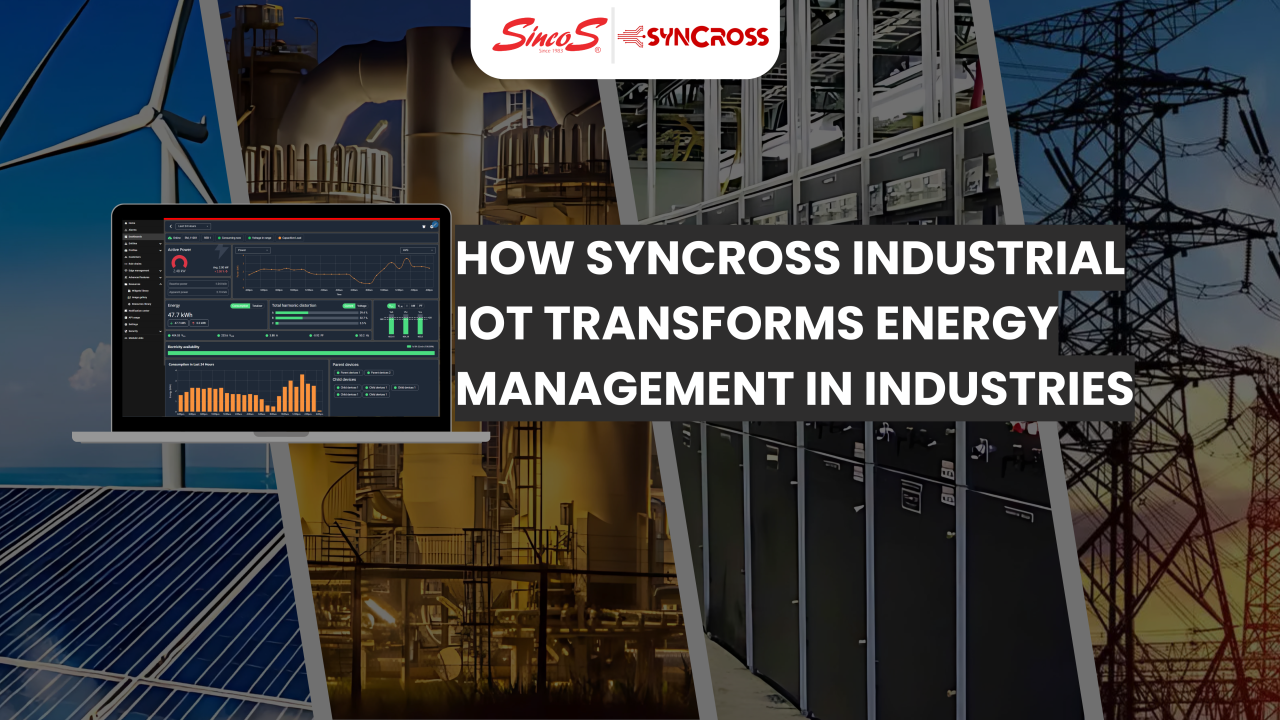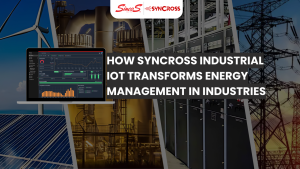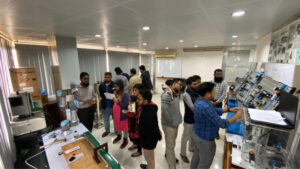In today’s rapidly evolving industrial environment, achieving energy efficiency is more crucial than ever for businesses striving to lower operational expenses and embrace sustainability. Syncross Industrial IoT (IIoT) delivers a sophisticated and intelligent energy management system (EMS) that allows industries to seamlessly monitor, regulate, and optimize energy consumption in real-time. By harnessing the power of advanced IoT technology, machine learning algorithms, and cloud computing, Syncross IIoT equips industries with actionable insights, enabling them to maximize energy efficiency and minimize waste effectively.

The Role of Syncross IIoT in Energy Management
Syncross IIoT provides a comprehensive energy monitoring solution that integrates seamlessly with industrial automation systems. It offers enhanced visibility and control over energy usage. Below are the key ways Syncross IIoT enhances energy management for industries.
1. Real-Time Energy Monitoring and Analytics
One of the core features of Syncross IIoT is real-time energy monitoring. With its cutting-edge sensors and cloud-based dashboards, industries can track their energy consumption patterns instantly. The system provides detailed insights into:
- Power consumption at different operational levels
- Energy efficiency of individual machines
- Historical energy usage trends
- Peak load analysis
- Real-time alerts for anomalies
This level of granular monitoring allows industries to pinpoint inefficiencies and implement corrective measures promptly.
2. Predictive Maintenance for Energy-Efficient Operations
Energy waste often results from faulty or underperforming equipment. Syncross IIoT’s predictive maintenance feature leverages AI-driven analytics to detect potential failures before they occur. By continuously analyzing machine performance, the system:
- Identifies abnormal energy consumption
- Predicts wear and tear on critical components
- Optimizes maintenance schedules
- Reduces unexpected downtime
- Enhances the lifespan of industrial machinery
This predictive approach ensures that machines operate at peak efficiency, minimizing unnecessary energy loss.
3. Smart Load Management and Demand Response
Syncross IIoT provides intelligent load management that dynamically adjusts energy consumption based on real-time demand. The system enables:
- Automatic load balancing across different machines
- Shifting non-essential loads to off-peak hours
- Preventing overloading and energy surges
- Coordinating with grid demand response programs
By managing energy loads efficiently, industries can lower energy bills and reduce carbon footprint, contributing to sustainability goals.
4. Integration with Renewable Energy Sources
With the increasing adoption of renewable energy sources such as solar and wind power, industries need a smart system to integrate and manage multiple energy sources. Syncross IIoT enables:
- Seamless integration of solar panels, wind turbines, and battery storage
- Real-time tracking of renewable energy generation
- Optimized switching between grid power and renewables
- Maximization of self-consumption to reduce dependency on external suppliers
By incorporating green energy solutions, Syncross IIoT helps industries achieve energy independence and regulatory compliance with environmental standards.
5. AI-Driven Energy Optimization and Cost Reduction
The AI-powered algorithms in Syncross IIoT continuously analyze energy data to provide actionable insights for cost savings. The system:
- Detects inefficient energy usage patterns
- Provides AI-based recommendations for process improvements
- Automates energy-saving actions based on operational needs
- Reduces overall carbon emissions and energy costs
By leveraging machine learning, industries can optimize processes in real time, ensuring sustainable and cost-effective operations.
6. Customizable Dashboards for Comprehensive Visibility
Syncross IIoT provides fully customizable dashboards tailored to specific industry needs. These dashboards offer:
- Live energy consumption metrics
- Comparative analysis between different sites or departments
- Automated reports for regulatory compliance
- Mobile access for remote monitoring
With intuitive dashboards, industries can make informed decisions to optimize their energy consumption strategies.
7. Compliance with Energy Regulations and Sustainability Goals
Energy regulations are becoming more stringent worldwide, requiring industries to adhere to strict efficiency standards. Syncross IIoT helps industries:
- Meet global energy efficiency compliance standards
- Reduce carbon footprint through smart energy management
- Achieve corporate sustainability goals
- Generate accurate reports for environmental audits
By staying compliant, industries avoid hefty penalties while contributing to a cleaner environment.
Industries Benefiting from Syncross IIoT Energy Management
The Syncross IIoT platform is highly adaptable and benefits various industries, including:
- Manufacturing: Reduces energy waste in production lines.
- Food & Beverage: Optimizes refrigeration and processing equipment.
- Oil & Gas: Enhances efficiency in extraction and refining operations.
- Pharmaceuticals: Ensures energy efficiency in sensitive manufacturing environments.
- Water Treatment: Reduces energy costs for large-scale pumping and filtration.
- Automotive: Improves energy usage in assembly and robotic operations.
Conclusion: The Future of Industrial Energy Management with Syncross IIoT
As industries move towards sustainable and efficient operations, the role of Syncross Industrial IoT in energy management becomes increasingly vital. With real-time monitoring, predictive analytics, AI-driven optimization, and seamless renewable energy integration, Syncross IIoT helps industries cut costs, reduce emissions, and enhance operational efficiency.
By implementing Syncross IIoT, industries gain a competitive edge in energy management, ensuring long-term sustainability and profitability.






